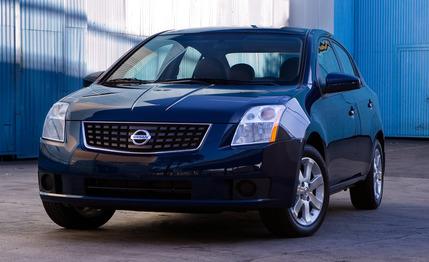 Review
Review
Introduction
Nissan’s compact Sentra plays in an increasingly competitive league, thanks to the growing number of consumers who are gravitating to smaller cars. Within the Nissan lineup, the Sentra occupies the space between the less expensive and slightly smaller Versa and the larger Altima family sedan. The Sentra was redesigned and basically all-new for 2007.
Although the Sentra is small on the outside, its high roofline and 105.7-inch wheelbase (among the longest in the class) yield a spacious and airy cabin that actually puts the Sentra in the EPA’s mid-size class. For those over six feet in height, the Sentra may prove to be the best-fitting of the compact segment. Interior design is decidedly modern, but the materials used can feel a bit cheap and actually trail behind those of the less expensive Versa.
The high roofline pays dividends in interior volume, but it also raises the center of gravity, which can give the Sentra a tippy and unsettled feel. In the regular Sentra, the shocks are tuned for a supple rather than sporty ride.
The Sentra comes in several different trim levels. The most basic is the 2.0, with the 2.0S, 2.0SL, SE-R, and SE-R Spec V following in the hierarchy. Two engines are available in the Sentra. The 2.0 models are, not surprisingly, powered by a 140-hp, 2.0-liter four-cylinder engine. A six-speed manual is available, as is a continuously variable transmission (CVT). Fuel economy for Sentras powered by the 2.0-liter comes in at 21 mpg city and 29 mpg highway for the six-speed manual and 24 mpg city and 30 mpg highway for the CVT-equipped model.
SE-R models get a 177-hp, 2.5-liter, and the top-dog Spec V gets a 200-hp version of the same engine. Regular SE-R models come exclusively with a CVT; the more powerful Spec V gets a six-speed manual transmission. According to the EPA, the SE-R will consume a gallon of gas every 24 miles in the city and every 30 on the highway. Spec V versions come in at 21 mpg city and 29 mpg highway.
In a recent comparison test, a Sentra 2.0S finished in last place behind five of its peers: a Toyota Corolla, a Hyundai Elantra, a Honda Civic, a Mazda 3, and a Volkswagen Rabbit. The Sentra’s handling and chassis didn’t impress.
In a five-car comparison test of sporty compacts, a Sentra SE-R Spec V finished in fourth place ahead of the previous-generation Subaru Impreza WRX—a result that was not without controversy within our office. Although the SE-R Spec V did somehow manage to beat the WRX, it lost to a Mini Cooper S, Volkswagen GTI, and Mazdaspeed 3—cars that all delivered far more driving pleasure and refinement. Furthermore, the Spec V wasn’t as quick as the competition.
Verdict
Spacious and comfortable, the Sentra lacks the fire in its belly that makes us enjoy driving. For those interested in mere transportation, the Sentra may fill the bill. SE-R versions improve the driving experience to some extent but still fall short of the competition.
Click here to read our full review of the Nissan Sentra SE-R and SE-R Spec V.
Click here to read our latest comparison test involving the Nissan Sentra.
Click here to read our latest comparison test involving the Nissan Sentra SE-R Spec V.
What’s New for 2009
The Sentra enters 2009 with no major changes. The color palette receives a few new shades, the trunklid now can accommodate a European-sized license plate, two 12-volt power outlets are added, and the CD player is now MP3-compatible.
Highlights and Recommendations
For those interested in the basic 2.0-liter Sentra, the 2.0S strikes a nice balance between price (about $18,000) and equipment, and it can be had with a six-speed manual transmission, which we prefer to the CVT. Base 2.0 models ($17,500) may seem too spartan for most buyers, and the 2.0SL’s (above $20,000) standard equipment borders on decadent.
The $21,000 SE-R Spec V would be our choice of the high-performance Sentras. The extra power, available manual transmission, and stiffer chassis make it more appealing than the lesser SE-R. We prefer a VW GTI or Mazdaspeed 3 to either, though.
Safety
Dual front, front-seat-mounted side, and front and rear side-curtain airbags are standard. Front seatbelt pretensioners, front-seat active headrests, and a tire-pressure monitoring system are also included on all Sentra models. Anti-lock brakes with electronic brake-force distribution are optional on the base Sentra 2.0 and standard on all other trims. Stability control is not available on any Sentra.